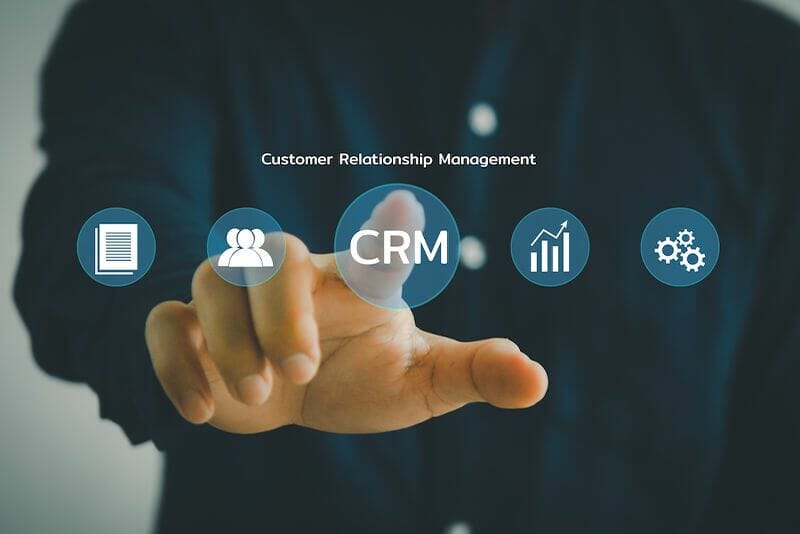Perfected marketing. Glowing reviews. Huge profits.
We’re not asking for much, right?
Just kidding– we know there’s no perfect algorithm or approach to business. We also know not every customer will be happy and not every transaction will go smoothly. Mistakes will be made and learned from…and probably made and learned from again.
But whether you’re selling to other businesses or directly to consumers, a CRM like Zoho CRM is going to get you closer to your goals than you even realize!
We talk a lot about B2B approaches, so today let’s focus on why Zoho CRM could be just the thing your B2C biz needs!
There are a whole lot of acronyms out there in the business world (and the world in general), and we don’t expect you to know them all. However, B2C and B2B are two commonly used phrases and it’s good to know the difference between them.
Both refer to selling something (whether a product or service) to someone else. They differ in who the intended buyer is and what category that buyer would fall into.
B2B stands for Business to Business, and refers to companies that sell to other companies. Zoho and all its offerings, for instance, would be considered B2B.
B2C stands for Business to Consumer and refers to companies that focus on selling to individual people.
The difference seems pretty obvious, but what really makes them different is the approach companies take and the buyer process. Sure, whether B2B or B2C, companies are going to market what they offer and try to entice their ideal audience. When you market to another business, however, it’s an entirely separate ball game: that buyer has to run their options through coworkers and managers. They might even have to run purchase decisions through multiple departments and be obligated to stick within a budget.
A B2C model can target impulse buyers and trendy markets; it can think more short-term. Individual consumers will consider both low-price items and high-price items, whereas B2B buyers will often be spending quite a bit to achieve a long-term purpose. B2C companies are all around you– they sell dog food, sneakers, cell phones, and whatever else you may need on a daily basis.

Not the best use of acronyms, but you get the point. So back to what we mentioned earlier: How can a CRM be helpful to a B2C model?
First, let’s review what a CRM is:
CRM stands for Customer Relationship Management and the meaning is pretty straightforward– CRMS focus on obtaining customers, convincing customers to make a purchase, and building and maintaining these customer relationships.
Keeping a close eye on the sales funnel and what works (and what doesn’t work) creates valuable insight for companies. How did they find a customer? What information did they initially obtain? At what point did the customer transition from a shopper to a buyer?
CRMs help collect information, develop leads, and create conversions. They also help you follow-up with customers.
Without a CRM like Zoho CRM, lots of information can get lost in the chaos. Many opportunities can be missed and companies may struggle to grow. Effectively using a CRM can help create loyal customers and make your business completely scalable.

Expanding further on what we discussed above, Zoho CRM can help your business in so many ways:
Collect valuable metrics - Easily create sales reports and view analytics with one click. Share these reports with the team and use them for process improvement. Analyze your sales funnel and its effectiveness while keeping tons of valuable information organized and attainable. Make smarter, data-backed decisions!
Organize leads and contacts- Zoho allows you to merge other CRMS with their system so you can have all your data in one place. It will also help you collect contact info and determine what leads are worth pursuing. They have products like SalesIQ to make this piece even more seamless.
Analyze your process- Zoho CRM will help you take a look at your sales processes and figure out where some holes could be. Define a process for your sales team with Zoho’s Blueprint function and optimize each step through the sales pipeline.
Communicate with customers- After all, customers are the focus with CRMs! Keep in touch with both actual customers and potential customers through email, social media and your website. Keep involved in the conversation people are having about your business!
Manage inventory- Zoho CRM is not just limited to contact information! Let it help manage your inventory and keep your ecommerce side operating better than ever.
Familiar integrations- We love to see some awesome integrations, and Zoho has a lonnngggg list of them! Many of these integrations are applications and companies you are beyond familiar with, which is a huge plus.
One of the best ones? Google Ads! Your business won’t get far without the help of Google, so why not have your CRM work alongside it? Other great integrations that you’ll recognize are Shopify, Quickbooks, SurveyMonkey and the entire G-suite!
Great Zoho integrations- Easily add on Zoho’s 40 other products and create the ultimate combo for your business needs. You even have the option to upgrade to Zoho CRM Plus or Zoho One and immediately get more benefits from their additional features!

If it isn’t already clear, we are huge fans of Zoho CRM here at Woggle! We also happen to be huge fans of a smooth process and a successful business– good thing they all go hand in hand!
Invest in your customer relationship and mitigate some of those unnecessary headaches– give Zoho CRM a try!
Sales orders may be something you never thought you would voluntarily read a blog post about, but boy are we ready to rock your world!
Okay, let’s be honest here: There’s no surefire way to make the topic of sales orders exciting, but there are definitely some undeniable reasons for why you should be using them in your product-based business!
Is it hard to imagine incorporating more forms and steps? Does it seem overwhelming to alter/add to your current process? These concerns are all understandable! We totally get it, and we’re here to show why a little extra virtual paperwork might not be such a bad thing for your biz!
All the terms within a sales process can get repetitive and confusing. So what is the difference between these terms you hear all the time? Well, let’s start with the first part of most sales processes: the quote.
A quote is the estimate a potential buyer/customer would request from a seller. In return, the seller creates a quote consisting of prices and other pertinent details about a potential purchase.
Next, you would have a purchase order (if the customer decides to make the purchase based on the quote). A purchase order is an official document and details what the customer plans to buy from the vendor.
Following the customer’s intent to buy, a sales order comes into play. A sales order will accept conditions laid out in the purchase order and reflect other details about the transaction. A sales order will contain items like delivery information, timelines, and payment method. It also includes prices and quantities.
To sum up the whole process, an invoice is sent. Invoices reflect information confirmed in the sales order, but focus more on collecting payment from the buyer.

For starters, sales orders are the only piece mentioned above that reflect the interests of both parties involved. A quote is controlled by the seller. A purchase order is controlled by the buyer. The invoice is for the seller’s benefit (gotta get that cash!).
A sales order, however, represents what both the buyer and seller need from a purchase; it reflects both sides of a sale.
Does the sales order accurately line up with the purchase order? Does the seller have the inventory needed to ship immediately? A sales order keeps both parties in the loop and ensures a successful transaction.
Sales orders can give you some extra beneficial data for reference down the road. No one wants to be audited– but it’s just a part of being a business owner. Wouldn’t it be nice to have a few extra bits of information for peace of mind and an easier process? Wouldn’t it be convenient to have a better trail with less likelihood of getting lost combing through years of sales? Sales orders give you more precise documentation that can really help with compliance and save you major hassles.
Back to the less scary stuff: this extra data can even help your business grow and succeed! Yes, you read that right, a simple sales order is better for your business!
Sales orders can help you better track inventory and make helpful projections about future needs.
For instance, if you have a frequent customer that keeps making multiple purchases within a short time frame, you can use sales order data to optimize and properly manage your inventory process. Know when to order items and know when to hold them for customers. Not to mention, you can create multiple sales orders for this customer and only send out one invoice! Save yourself some time and effort, while continuing to collect useful information.

Aw, did that sentiment give you the warm fuzzies? Well, we aren’t lying: you have the support you need to run a successful business! So if you are overwhelmed about dealing with this sales order stuff alone, have no fear- Zoho Books is here!
No, but seriously, Zoho Books can truly guide you through a potentially confusing process. Not sure how to even create a sales order? Zoho has templates. Have multiple brands that are getting hard to juggle? Zoho Books can juggle them for you! You can personalize your sales order and create a separate style for each of your brands.

Zoho Books also makes it super simple to convert a quote into sales order all in one place. Then once it’s time to collect payment, easily convert it to an invoice! All it takes is one click from a drop down menu.
Only have the inventory for part of the order? Zoho Books can help you send a partial invoice so you can go ahead and send the stock you have! Make the customer feel appreciated and build a trusting relationship by not making them wait forever for their order!
Zoho Books even lets you switch sales orders to purchase orders so you can buy that inventory you’re missing! And like with all things Zoho, you get valuable insights and information as you go. Plus, you can easily communicate anything you want to your sales teams and coworkers.
Now that you understand why sales orders are important, we hope you feel better about incorporating them into your business! Make that sale and keep those customers coming back by continually improving your sales processes!
Zoho Books is a great way to manage this crucial aspect of your business, and we can’t wait to hear how some simple changes will benefit your biz!
Want to find out how we can help you? Book a FREE consultation!
Annnd we are back with yet another great episode of Zoho Books: Accounting Software Extraordinaire! Boy is this a series we could easily binge-watch… Ok, maybe Zoho Books and chill doesn’t seem all that appealing- we get that. Something that does seem appealing? Another great Zoho Books integration that makes the tax side of your small business seem like less of an obstacle: Avalara!
With this handy integration, Zoho Books not only has your accounting under control, but you’ll be able to rest easy knowing you are sales tax-compliant!
Growing your business takes a lot of time and energy; why not focus on what’s important while Zoho Books and Avalara take care of the nitty gritty money details? Makes perfect “cents” to us! (Don’t worry, that’s it for the puns for today.)
If the accounting world had high school superlatives, Zoho Books and Avalara would 100% win the cutest couple title. Now you may think that’s a bit extreme, but hear us out!
First of all, Zoho books allows you to automate all your business’ accounting needs for a very fair rate. Invoices, reports, inventory-tracking– Zoho Books has a feature that covers just about anything you can think of.
However, one thing we are missing from this accounting equation: the expansive and mysterious world of sales and use taxes. (Does reading the word ‘taxes’ make you cringe? Because it sure did make us cringe as we wrote that.)
That’s where Avalara fits in perfectly: they offer cloud-based software that can help just about any size business remain tax-compliant. Whether small, midsize, or enterprise– your business doesn’t have to continually battle the confusion and overwhelm that taxes can cause. Struggling with keeping track of all the new regulations? Confused about the categories your business falls under? Avalara is built for businesses with questions just like these!

Sick of manually entering everything and doing the math yourself? Does it make you nervous to count on free applications and websites to take care of such an important task? Avalara is a great way to automate your sales tax situation while you focus on everything else that’s important!
Plus, Avalara can truly be a ‘set it and forget it’ scenario, because they will add updates and automatically keep everything compliant no matter the random changes.
Do resources on taxes often create more questions, rather than answering the ones you came there for? Don’t worry, it happens to us all the time. (It may have even happened to us as we wrote this very blog post…)
So, we’ve accumulated a list of things that we wanted more clarity on, and that Avalara just so happens to take care of for you:
Did you know you have to register your business before collecting sales tax? Any state where you make sales, you have to register your business with that state. If it sounds like a hassle (and too much paperwork), that’s where Avalara steps in and not only simplifies the process, but makes sure you have registered in all the right states.
Does your state offer tax exemption holidays? Do you know who qualifies as exempt? Does your product/service qualify for exemption? If you’re like us and don’t have time to worry about details like this, Avalara knows all the answers to these questions and more.
Like we mentioned before, you won’t have to worry about any new laws or changes with Avalara around. They do all the research for you!
Location is important when it comes to sales and use taxes. Do you understand your jurisdiction? Are you charging the right amount of taxes for your jurisdiction? Turns out your jurisdiction is way more than a zip code! Avalara can determine all of this for you (or confirm you have been doing it correctly).
If you conduct a certain type or amount of business in a given state, you have possibly created a nexus in that state. This means you must collect sales taxes and pay them what you collect. Even better, every state has different rules (yes, we’re serious). Sounds like we’ll let Avalara handle that potential nexus chaos!
Does your business involve more than just straightforward retail? Are you unsure of how to proceed with sales taxes? Are you unsure if you even need to collect sales taxes? With things like short-term rentals, you may be missing some tax items, whereas you don’t have to worry about it under a marketplace facilitator like Etsy. Avalara will look at all these factors and determine what you need to consider!
If you run sales through your site and use an ecommerce solution like Shopify or Squarespace, you have to collect your own sales tax. Thankfully Avalara can seamlessly integrate with your ecommerce platform and make that way easier!

Avalara is just one giant confidence boost for business owners, and that’s something we can get behind! Put your mind at ease and walk away feeling:

Honestly, we keep thinking of more and more great things about the Zoho Books and Avalara duo, but we want to keep this short and sweet. Head on over and check out what options are a great fit for you and your business!
Emails are so fun! They are the highlight of my day! (Said no one ever).
How do I start this email? How do I sign this off? Is this too formal? Did I use too many exclamation points? Did I put in the correct address? HOW DO I LEAVE THIS EMAIL CHAIN?
Emails get a bad reputation because they are associated with work and that’s just no fun! However, they have become a communication staple and most organizations can’t conduct business without them.
What’s our point? Maybe it’s time to stop hating email! Since it’s pretty much inevitable, maybe it’s time to embrace the things that make email a little easier (and possibly more enjoyable)!
That’s where our lovely friends at Zoho come in with another awesome product: Zoho Mail!
Let’s talk about a few ways Zoho Mail can make emails a little less nightmare-ish for you and your business!

If it’s not customizable, it’s more than likely not going to be Woggle-approved. Lucky for you, Zoho Mail has passed our rigorous tests and is more than capable of becoming an all-star email solution for your business!
Zoho Mail allows you to easily manipulate basic items like password policies and spam filters. Set conditions and create guidelines that are optimal for your business; You can even create groups with specific group moderators and assign roles all from one convenient control panel.
One of our favorite Zoho Mail features? Custom domains! Ever get tired of the same old domain options? Have no fear– you can create your own domain using your company name! For example, we could claim wizards@woggleconsulting.com as our very own! (Maybe we should seriously consider this…)
But in all seriousness, you can use a custom domain and create an email for different departments or individuals. You can also create multiple email aliases. As an added bonus, there’s no limit to the number of custom domain email addresses if you choose a paid plan!
Streams is another great aspect of Zoho Mail that keeps things running smoothly. Communicate with the team on a shared wall, start a group chat, or even collaborate within an email. Yes, you read that right– Streams allows you to consult people about a draft before you even hit send!
Instead of a lengthy, confusing, and time-consuming email thread, Streams allows everyone to easily tag each other and collaborate in a more “social media-esque” way.
Data privacy and security– that’s what we like to see! With the topic of email, data is an especially important topic that no business should ignore!
Are they selling my data? Who can access my data? Where is data security on their priority list?
Thankfully Zoho takes this very seriously and offers an abundance of features that make your email super safe. Zoho is GDPR compliant, ensures emails are encrypted, and even includes unusual activity reports among their lengthy list of features.
You can also enjoy an ad-free mailbox (yes, ad-FREE) and rest assured that they aren’t using your data to tailor ad campaigns.
Zoho makes sure none of their own employees can access your data/emails unless there’s a very specific reason or help request! You can even set your own password policy and have all users reset passwords as consistently and often as you please.

Like other “suites” out there, Zoho Mail offers a handy Calendar feature along with Tasks and Notes.
Take a peek at their website for more details, but there are five incredibly convenient ways to create tasks, including directly pulling info from within an email. You also have the option to create subtasks, along with notifications and email reminders.
Worried about transitioning to an entirely new email service? Zoho Mail has you covered with their migration tools: move over your emails from any provider with Zoho’s migration wizard! (We’ve talked a lot about wizards in this blog post…)

Use the mobile apps or access everything on your desktop– whatever is most convenient. Zoho Cliq is another great option that will sync all your Zoho information on all your devices!
Have multiple tasks created within Zoho Mail along with tasks from other products? You can easily see all your Zoho tasks all on one convenient screen! Access your control panel wherever, whenever and with offline mode, you can work in Zoho Mail even when Wi-Fi’s not the most dependable.
We could talk about the wonders of emails for days..
Okay, that’s actually not true– but we could easily talk about the wonders of Zoho Mail for days! Like any other great Zoho product, Zoho Mail has tons of great features at a great price point. (And if your business has 5 or less employees, you can actually use Zoho Mail for free!)
Reasonably priced, accessible, and tons of awesome integration options– Zoho Mail may just be the perfect email solution for your business!
Want to find out how we can help you? Let’s chat.
You didn’t quit your 9-5 to start a business that is “just fine”. Let’s face it, you started up a business to serve a mission. To follow your passions, to make an impact, to set impressive goals and attain those goals.
There’s a bit of fantasy behind every entrepreneurial venture, and the last thing we want to think about are the challenges and hard work between us and that dream.
But what if we took a different look at the process? The pathway to success? What if instead of getting discouraged because we aren't seeing instant success or profit, we reanalyze the factors that got us here?
The Aggregation of Marginal Gains concept is not only a great concept to apply to our business mindsets, but also a great addition to our personal mindsets. It emphasizes the journey more than the end result.
Time to take a deeper dive into this inspiring notion!
This may come as a surprise, but the Aggregation of Marginal Gains concept did not come from an entrepreneur, inventor, or economist. It did not come from an author or a professor. Nope– it came from a man named Dave Brailsford, the Performance Director/Cycling Coach for British cycling!

After years of discouraging losses, David Brailsford stepped up for the British cycling team and started to dissect all the elements that may affect performance. Diets, bed pillows, van cleanliness– you name it, he analyzed it!
Brailsford then improved every one of these elements by 1%. His theory was that every small change can compound into long-term improvements and that incremental change would slowly lead to significant outcomes.
Even though this may seem a bit meticulous, his theory proved valid: The team went on to win 7 Tours de France within 8 years and won 16 Olympic gold medals. (Pretty noteworthy results if you ask us!)
Basically, the Aggregation of Marginal Gains means it pays to focus on the smaller picture versus the big picture/end goal. Sometimes we can get distracted by the big picture and multiple ideas. Not only can this mentality be overwhelming, but it can be a huge time-waster.
It makes sense to implement small, gradual changes instead of huge, quick changes. Continuous process improvement will pay off in the long run! This mindset is a lot more likely to keep you on track and headed toward an important achievement.

We have now seen this concept in a cycling example, but what about an example that pertains to more people? Don’t worry– there are a lot of ways marginal gains can be incorporated in your life, both personally and professionally!
Physical exercise is a great application of this concept, since a few minutes a day over a long period of time can bring great results. Another application is journaling daily to improve mindfulness or listening to an educational podcast a few times a week. In terms of your business, you could try to automate an additional process each month or slowly change the structure of sales conversations or marketing approaches. The options are endless!
In our research on this topic, there seemed to be a few additional points that deserve mentioning. After all, no concept can be blindly applied to absolutely every situation!
Be practical- The idea behind the Aggregation of Marginal Gains is the buildup of change over time. But guess what? If you run into obstacles or lose motivation, it can destroy any progress and delay the ultimate goal.
It’s important to be able to stick with elements that you change or adapt. If you commit to running 5 miles a day when you don’t currently run, you are likely to lose momentum early on. If you set a more realistic goal, like running/walking for 30 minutes every other day, you are much more likely to see success.
Consider marginal losses- Although this may sound negative, it really doesn’t have to be. Incorporating marginal losses means gradually cutting out habits that detract from your goals. For instance, eat out less or eliminate one unnecessary business expense each week. By losing one habit, you can gain momentum in a positive direction!
Define your focus- The Brailsford story makes it seem like you have to slowly improve everything, but that’s not exactly the case. If you try to focus on everything, it may end up being counterproductive! It’s totally okay to define factors that have a heavier impact and concentrate your focus on those things.

Sure, the initial focus may have been on those gold medals, but what else can the Aggregation of Marginal Gains concept bring us (and our businesses)?
You may see a better team dynamic. Sometimes troubleshooting and working together on continuous improvements can be motivating for a team!
You may see less of a focus on an end goal and more of a focus on the process. Attention may shift towards the impact of individual changes and valuable lessons learned along the way.
You may discover a new definition of success. Rather than instant gratification or quick results, you achieved something that took long-term motivation and refining details/skill sets.
Small changes, major impacts! The Aggregation of Marginal Gains concept may initially serve a direct purpose, but it can also indirectly affect a myriad of other things. Where do you see this concept fitting into your life and business?
Contact us for a consultation!
As a business owner, many decisions have to be made–not just any old decisions but also informed decisions.
How do you know what the best decision is from limited information? What if you choose something that negatively impacts your business? You are not alone in these entrepreneurial conundrums!
This overwhelm, and self-consciousness is part of what drives us here at Woggle– we want to provide the information that helps guide you toward a business solution that fits your business.
As part of our desire to share the best tips and information, we are highlighting a Zoho product today. We love Zoho for many reasons, and we often mention Zoho One and the 40 (plus) applications it has to offer, but today we are taking a deeper dive into Zoho Projects and what it can do for your team!

Ah, what an excellent place to start! Zoho Projects is a cloud-based project management software ready to take on all your team project challenges! (Even though we kind of made it sound like a superhero, we can’t promise you that it will be quite that exciting.)
It may not save people from space creatures and collapsing buildings, but it can improve productivity, increase profitability, and keep things transparent with clients. Not to mention, in this world of growing amounts of remote work, Zoho Projects enables your team to work from anywhere with an internet connection efficiently. There are even applications available for IOS and Android if you need to work from your mobile device!
The word ‘customize’ may mean something different for everyone, but it highlights a key aspect: catering a solution to fit our individual business needs. There’s really not a one size fits all option out there (no matter what other services want you to believe).
Not only can you control the theme/colors and layout, but this project management software allows you to create templates that work for your tasks. It also lets you create tags and customized statuses to help organize your project even further!
We don’t deny that several software options are available that enable collaboration efforts. However, Zoho Projects kicks collaboration up several notches.
Like other options, they offer ways to share documents; team members have access to files when and wherever they need them. Additionally, Zoho Projects provides a chat function and a shared feed where contributors can comment, make announcements and step up team communication.
One other incredibly convenient feature is the ability to control items from your email. Yes, everyone can create tasks, report issues, and even upload a document– all from the comfort of their email.

When you purchase a Zoho product, it rarely limits you to just a particular set of applications. Zoho Projects is no different! You can utilize Projects along with Zoho Books, Invoice, People, and so much more.

No one puts Zoho in the corner– it’s fully willing to play with others! Don’t worry if you can’t accomplish everything within Zoho Projects because it easily integrates with software like Dropbox, Slack, and Microsoft 365. Even better, it easily integrates with Zapier and the 2000 automation applications it has to offer!
There are virtually endless resources with every Zoho product to help you get through the speedbumps. Zoho Projects has a Tips and Tricks section that comes in handy. It also has videos, webinars, and forums to help your business take advantage of the software. If you hate buying a product or service, Zoho may be an excellent fit for you!
You pay 5 dollars a month for their premium subscription per user. You can also pay for client users, which will help keep transparency with your clients at a level they will certainly appreciate!
So, Zoho Projects is one of the most cost-effective options. For 15 team members, it will cost you around $307 dollars monthly to use Asana. It will cost you around $900 dollars annually to utilize Monday.com for ten users.
Check out the price comparisons for yourself, but Zoho is winning this battle so far!
If we haven’t converted you into a full-blown Zoho fan, we hope this spotlight at least presents a few key factors to consider.
It is worth putting in the time and effort to make the best purchases for your business. Got more questions? Schedule a free consult with us today to get them answered!
Chances are, you have used spreadsheets at some point in your life. For business or personal tracking purposes, spreadsheets are commonly used and can be pretty handy.
However, as new software and resources become available every day, are spreadsheets relevant? And more importantly, is the spreadsheet route genuinely ideal for your business?

For every devoted spreadsheet fan, there’s also a scary anecdote– like that time when JP Morgan Chase lost over 2 billion bucks because of one spreadsheet error.
Okay, okay– enough with the extreme (and terrifying) examples. It’s time for you to decide for yourself whether you are Team Spreadsheet or not. And to help, we’ve listed out some nice pros and cons for you to consider.
Well, there you have our list of spreadsheet pros and cons. As a company that’s all about automated solutions and making the lives of business owners a little easier, Woggle tends to lean away from spreadsheets.
So, where do you stand on this 2022 Spreadsheet debate? (No pressure to take your side right this moment!) As always, if you remain confused about what options would be better for your business, Woggle is always here to help guide you in the right direction!
The “6P Rule” has been defined and applied in many different ways, always circling back to the main message: the importance of planning. What is the” 6P Rule”, exactly? 6P stands for Prior Proper Planning Prevents Poor Performance. The exact origin of the rule is unknown, but the emphasis on effective planning is a message we can all relate to.

Think of all the ways a lack of appropriate planning could impact your business. Is there something you could change that would have a positive impact? And more importantly, is it worth it?
Without some consistent structure for everyday tasks and events, we lack a realistic path toward business success. With proper planning, businesses can:
Establish clear project objectives - Clear objectives mean a clear timeline and an ability to plan out each workday to suit this timeline. This creates the opportunity for checkpoints, delegation, and other steps to lead to a better outcome.
Prepare better for the unexpected- We can’t predict every little detail, but we can plan for a better rebound from unforeseen issues. Thorough planning can allow for a more adaptable budget and backup options. You can also learn from previous problems and plan out how you would better handle them if they happen again.
Track progress- Planning well in advance can allow tracking developments and show where you fall behind. A well-thought-out plan can also be great to review down the road, emphasizing what can be adjusted or included next time.
Realistically, no one is a perfect planner, and there’s always room for improvement. Identifying our planning strengths and weaknesses can significantly impact overall business performance. Let’s take a look at a few ways to optimize your planning skills:

Don’t just make a list for the week; think of the best way to schedule tasks. Make sure you place the more challenging tasks first and get them out of the way. If you work better in the morning, reserve the more difficult tasks and place more manageable tasks in the afternoon. Procrastinating on more complicated tasks will only increase your chances of failing.
You also don’t want a ton of long-term goals on your to-do list. Break down long-term goals into short-term tasks. Not only is it more motivating to accomplish multiple short-term goals as you go, but it is more likely that you will complete the big goal on time.
What’s a part of every workday, even if we don’t consider them as “tasks”? Breaks. Plan out your days in a realistic way; schedule your lunch and any other breaks you should be taking. Don’t schedule a huge chunk of time working with no breaks. Be practical about what you require to keep motivated and concentrated.

This may sound trivial, but also attempt to schedule specific times for things like checking emails and updating your calendar. We are all familiar with the category tasks like these fall under unexpected time-suckers that tend to send us down random rabbit holes. Once you get distracted, it may be an hour before you get back on track!
Also, do not oversimplify your to-do list. If you have to complete a blog post, is it just one task that you can do in an hour? Of course not! Time goes into planning, research, and then eventually writing! Schedule out times for all the steps; don’t just make a generic “Write Blog Post” task. The same goes for things like client meetings and Zoom presentations.
There’s plenty of software out there that can make your life a little easier. One great way to optimize planning with some added benefits? Use a calendar application. A visual calendar may not seem overly complex on the day-to-day, but down the road, you can use it to identify patterns and weaknesses in your plan.
Another great way to utilize technology within your business planning? Team collaboration through options like Google Workspace or Zoho Projects. These applications are great for sharing plans, delegating tasks, and increasing overall productivity. And like the calendar applications, these tools can also make it easier for process duplication and improvement easier down the line.
In conclusion, no one wants to violate the 6P Rule, right? We wouldn’t dare! Don’t let a lack of proper planning negatively affect your business– there are easy and risk-free ways to make it less of a problem. And like always, there’s never a better time to start than now!
Need help planning a better plan? Woggle is ready to lend some suggestions!
Chances are your work team has its fair share of conflict, problems and miscommunications. It wouldn’t be “work” if everything ran smoothly all the time, now would it?

There may seem like there are way too many problems to fix. It also may seem like there are way too many solutions to choose from!
So, what issues have been causing conflict within your team? If you can quickly answer that question, but are stumped when it comes to the right fix, it’s your lucky day: We’ve rounded up a few common issues and the platforms that can help!
Smooth processes are key to serving your customers. They’re also important in establishing a decent work environment. No one wants to work at a chaotic job where operations are shut down every 5 minutes for an issue that was already fixed three times last week.
Errors happen. If your company is not working to reduce errors from a process or eliminate certain errors altogether, something is wrong. Continuous improvement is necessary for the success of your business and ultimately employee retention.
Programs like Zoho Flow can lend some help with workflow. Flow can assist with process automation and project management. Zoho Analytics is another level of double-checking what’s really going on in your business, and providing a further understanding of the problem. Allow Zoho to help you work out the kinks and keep things running smoothly.
Many things can go wrong when starting a new job. A few examples: A lack of thorough training, a lack of training altogether or receiving different training than your coworkers received.

Onboarding new employees should be consistent and effective. They should be given the tools to assimilate into their new environment and contribute to the team. Additionally, it not only needs to be a smooth transition for the new employee, but a seamless transition for the whole team.
How can businesses keep the onboarding process consistent and efficient without wasting time and resources? Zoho Recruit and Zoho People are applications that assist with Human Resources processes, along with applications that provide learning/training resources. Other options can keep procedures and paperwork all in one accessible place, like Zoho Writer and Zoho Workdrive.
Communication issues should probably be at the top of the list...and in the middle..and then maybe reemphasized again later. Our point? Communication is truly the root of many problems (and solutions). Why not invest in a platform that can make communication more effective? A solution that makes managers more reachable and updates more easily shared?
One great platform that comes to mind when we think of communication is RingCentral. Video conferencing, team messaging, secure communication- what more could a business need? Connect with coworkers no matter the time zone. Stop disruptions in communication from continuously disrupting workflow!

Gone are the days of constant in-person meetings, presentations and brainstorming sessions. Thanks to the pandemic, it has become more crucial than ever to have plenty of online resources that enable collaboration. Working remotely should never mean you have to work alone in every aspect!
Platforms like Zoho Sprints make team projects a breeze, creating a board for everyone to easily contribute to and access. Zoho Projects is another great option where the entire team can work on an organized list of tasks and projects.
Zoho Workplace offers additional options, with applications like Zoho Writer, Zoho Cliq, and Zoho Workdrive. It’s a one-stop shop where the entire team can upload information and easily share with their coworkers.
Sometimes there’s just not enough manpower behind what needs to be done. Your team may already be stretched too thin. Don’t add on to their to-do list and create more stress over an already tough project! It may be time to hire a freelancer or contractor that specializes in the task at hand. Or maybe your business would benefit from a consultancy (like us) guiding you in the right direction.
An even simpler solution? Utilize a platform that has no issue doing most of the work for you! Shopify is a great example of a platform that takes some weight off your shoulders: why put the time and money into becoming a website expert when Shopify makes it easy to jump right in to the ecommerce scene?

What exactly is Operational Excellence? Although born in the industrial arena, the idea of Operational Excellence can be applied to many facets of business. The goal? To provide business leaders and strategists with key principles that could potentially improve efficiency and effectiveness of company operations. Phew, that got wordy!
A deeper understanding of what goes into smoothly running a business will ultimately waste less money and time, helping to ensure a better future for the company. The guiding principles within the concept of Operational Excellence show you exactly what to consider to achieve that better understanding.
Dr. Shingo, an industrial-management specialist and productivity expert, had extensive knowledge of process improvement. He built a long and impressive resume, consulting with many companies over the years and helping them improve their production methods and business processes. One of the biggest companies he worked with was Toyota- you may have heard of them! Dr. Shingo helped Toyota develop the Toyota Production System (TDS), aka the birth of lean manufacturing.
Dr. Shingo narrowed in on keeping low levels of inventory to save money. He also created Poka-Yoke, a method of detecting manufacturing process errors and subsequently (and quickly) making necessary changes. Poka-yoke is not only a way to refine and enhance processes, it is a safeguard against human error. Dr. Shingo centered many of his key concepts around human error and the fact that it is inevitable.
It’s really no surprise that Dr. Shingo made the idea of Operational Excellence the business pillar it is today.
Operational Excellence consists of 10 guiding principles, all of which are further divided under “dimensions”.
✓ Respect Every Individual- Provide a respectful work environment for employees. Make sure they feel like they are a part of the business processes. Emphasize a team effort and the importance of inclusivity.
✓ Lead with Humility- Take input and feedback graciously. Leaders should be approachable and create a collaborative environment. They should be willing to face criticism and accept that their way is not always the right way.
✓ Focus on the Process- Don’t blame individual people for problems that should be blamed on a process. Work on creating the best process possible.
✓ Seek Perfection- Yes, human error exists and will always exist. Seeking perfection, however, opens the door to continuous improvement. Think big and think about long term solutions, instead of focusing on small steps and temporary fixes. Think more radically and less rationally. Don’t simply focus on what’s attainable: go beyond it!
✓ Assure Quality at the Source- Don’t try to hide potential errors in your process: create transparency and identify/fix errors immediately. Quality depends on the beginning stages- not correcting what went wrong way down the road.
✓ Improve Flow and Pull- The flow of a company’s process should not be convoluted by excess materials/products. The best way to ensure optimal flow is to answer directly to demand, and not keep extra inventory around.
✓ Embrace Scientific Thinking- This one is pretty straightforward: use trial and error to your company’s benefit. Seek data-driven solutions and research-based approaches. Encourage employees to have a scientific mindset.
✓ Think Systematically- Try to understand the big operational picture. How do processes interconnect? What will one process change look like for another part of the organization? Systems rely on several different pieces to properly function.
✓Create Consistency of Purpose- Ensure that everyone within the organization has a clear understanding of goals. Make employees confident in the vision of your organization and changes or improvements that may be required.
✓Create Value for the Customers- To put simply: the customer is always right. There is no business without the customer wanting what you offer. Operational Excellence isn’t possible without a heavy focus on customer needs.

There are all kinds of classes, books, and vlogs out there discussing the meaning and application of Operational Excellence. Others may disagree, but when we think about the concept of Operational Excellence, we see four key things emphasized:
Based on what you’ve read so far, how could you achieve Operational Excellence within your business? Have you identified any pain points you hadn’t really thought of before?
Let’s face it: there’s alway room for improvement. Sometimes these improvements are glaringly obvious, sometimes it takes a fresh perspective to see them. Let Woggle help you examine your process and what you can do better. We are here to help you discover and implement new tactics and approaches.
What will incorporating Woggle and all our resources leave you with? More time to focus on other aspects of your business! Just know we are always here to help in your journey towards achieving Operational Excellence!